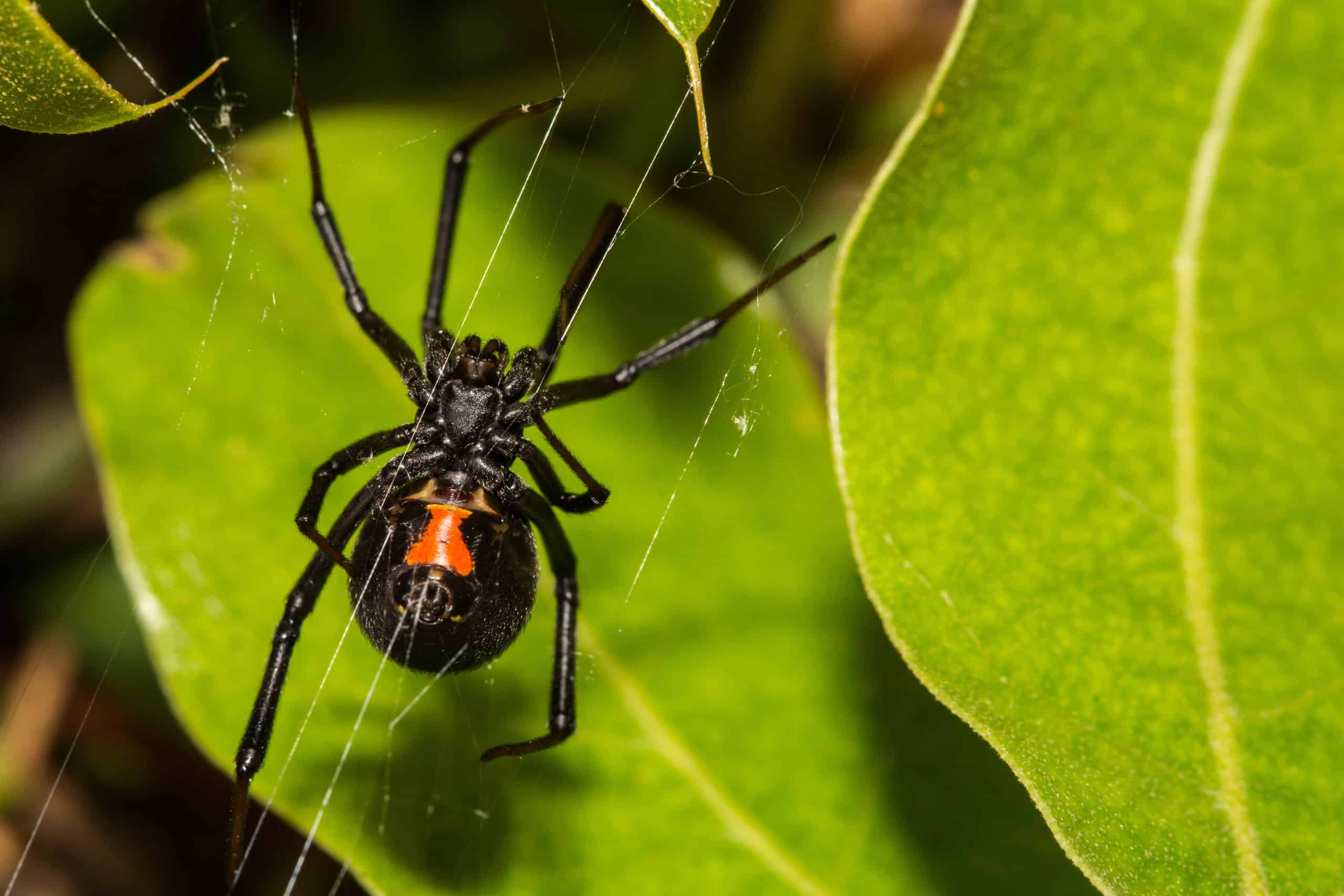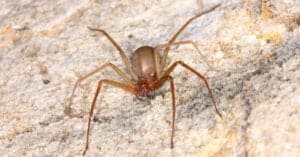Poisonous spiders found in the United States of America include, among others, the aptly named black widow and the shy brown recluse. Furthermore, the CDC states that these two types of spiders are the most harmful to humans (In other words, if one of these poisonous spiders bites you, you should seek medical attention immediately). In addition, these spiders can be dangerous to people who work outdoors but can occasionally make their way inside structures or buildings and pose a risk to those who work indoors. However, spiders aren’t always aggressive; most bites occur because a spider is trapped or accidentally threatened. Nevertheless, employers must educate their workers about their risk of exposure to poisonous spiders, how to protect and prevent themselves from spider bites, and what to do if they are bitten by any spider.
Types of Poisonous Spiders
Many people don’t know this, but most spiders are poisonous. However, out of more than 3,000 spider species in North America, only two primary species have poison toxic enough to harm humans. They are the black widow and brown recluse spider.
Black Widow

Black widow spiders will sometimes build webs between objects in a home, and bites typically occur when humans accidentally damage their webs.
©Dan Olsen/Shutterstock.com
The United States is home to five species of black widow spiders. However, while black widow spiders may be found throughout North America, they are primarily located in the western and southern regions of the United States. The pattern of red coloration under their abdomen is the best way to identify these spiders. Unfortunately, they are mostly found in workplaces with undisturbed areas such as woodpiles, fences, and other places where debris builds up. As a result, they may also occur in outdoor toilets where flies are abundant.
Black widow spiders will sometimes build webs between objects in a home, and bites typically occur when humans accidentally damage their webs. Furthermore, their bites can usually be differentiated from other insect bites by two puncture marks it makes in the skin when biting. The poison is a neurotoxin (a toxin that attacks the nervous system). As a result, it produces pain at the bite location and then spreads to the chest, abdomen, or entire body. Additionally, adult female black widow spiders have lethal poison but would rather flee than attack unless guarding their eggs. These females are usually black with a red hourglass marking on their abdomen. However, markings can also be yellowish – orange and the shape can vary.
Brown Recluse Spider

Brown recluse spiders are usually found in isolated, dry, covered areas, like underneath logs or in heaps of rocks or leaves.
©Nick626/Shutterstock.com
The brown recluse spider, sometimes known as the violin spider, is typically found in the Midwestern and southern states of the United States. In addition, the average size of mature brown recluse spiders is approximately 1/3 of an inch. Males and females are similar in size. Furthermore, it appears brown in color with a trademark dark violin-shaped marking on its head and has six identical-sized eyes, even though most spider species have eight.
Brown recluse spiders are usually found in isolated, dry, covered areas, like underneath logs or in heaps of rocks or leaves. However, if a brown recluse spider decides to wander inside a building, it may seek cover in dark closets, shoes, or attics. Interestingly, brown recluse spiders cannot penetrate humans’ skin without some sort of weight or pushback, for example, through accidental contact that corners the spider against the skin.
Bites may cause a stinging feeling with localized pain. Additionally, a tiny white blister usually forms at the location of the bite. Unfortunately, the poison of a brown recluse is necrotic and can cause a severe wound by attacking skin tissue, called skin necrosis, resulting in a large open wound called a necrotic lesion. So, if you have a skin lesion, you need to get to the hospital ASAP because only a doctor can treat it, as symptoms such as nausea, headache, abdominal cramps, and even kidney failure have been reported in some cases.
Symptoms and First Aid
Symptoms from spider bites can vary from minor to overwhelming. However, although extremely rare and not likely, death can occur in the most severe cases. Possible symptoms associated with a spider bite include the following:
- Itching or rash
- Pain coming from the site of the bite
- Muscle pain or cramping
- Reddish to purplish color or blister
- Increased sweating
- Difficulty breathing
- Headache
- Nausea and vomiting
- Fever
- Chills
- Anxiety or restlessness
- High blood pressure
First Aid
Once you are bitten by a poisonous spider, you must act as fast as possible. If you delay getting treatment, there can be severe repercussions. So, the following steps should be taken after a spider bite:
- Stay calm and identify the type of spider if it is possible to do so unharmed. Identification will help with medical treatment.
- Clean the bite site with water and soap and apply an antibiotic ointment, if available.
- Apply a damp or ice cloth to the bite area to reduce swelling, and hold for 15 minutes.
- Elevate the bite area if possible.
- Over-the-counter pain medication might help to relieve pain caused by a spider bite
- Do not attempt to remove the poison.
- For an itchy wound, you can use an antihistamine, such as cetirizine (Zyrtec) or diphenhydramine (Benadryl), which may help.
- Immediately seek professional medical attention.
Poisonous Spider Population by State:
Nearly every state has one or several poisonous spiders that occur both in rural and urban areas. Below is a list of the poisonous arachnids found in each state:
Alabama: Four
- Southern Black Widow – Latrodectus mactans
- Northern Black Widow – Latrodectus variolus
- Brown Widow – Latrodectus geometricus
- Brown Recluse – Loxosceles reclusa
Alaska: One
- Aggressive House Spider or Hobo Spider – Tegenaria agrestis
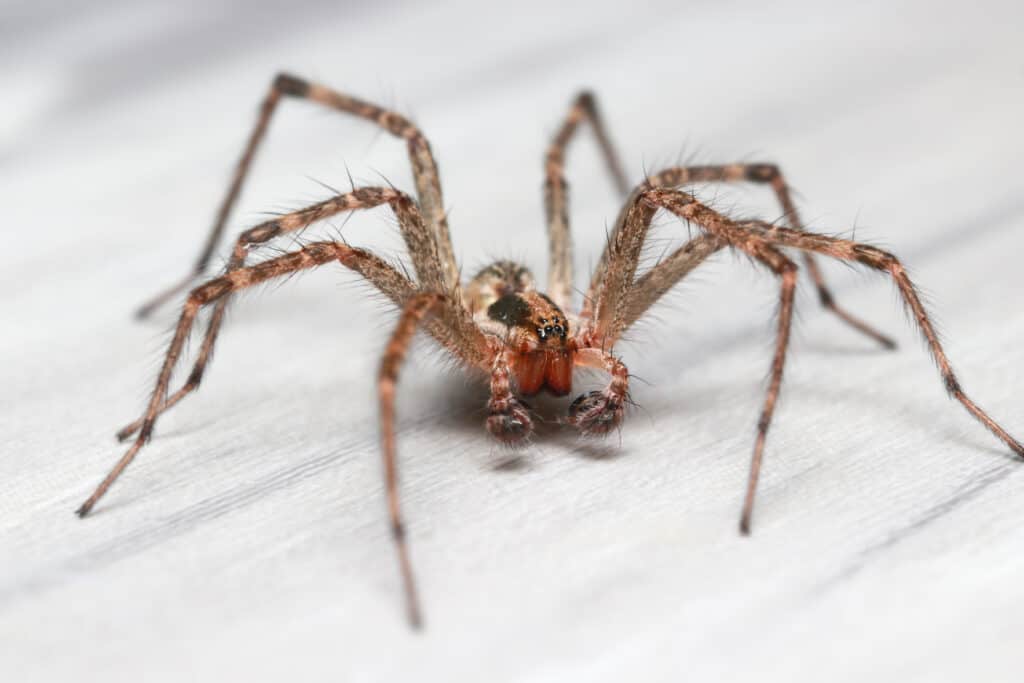
Hobo spiders are found in Alaska.
©SNEHIT PHOTO/Shutterstock.com
Arizona: Seven
- Apache Recluse – Loxosceles apachea
- Arizona Recluse – Loxosceles arizonica
- Desert Recluse – Loxosceles deserta
- Grand Canyon Recluse – Loxosceles kaiba
- Tucson Recluse – Loxosceles sabina
- Brown Widow – Latrodectus geometricus
- Western Black Widow – Latrodectus hesperus
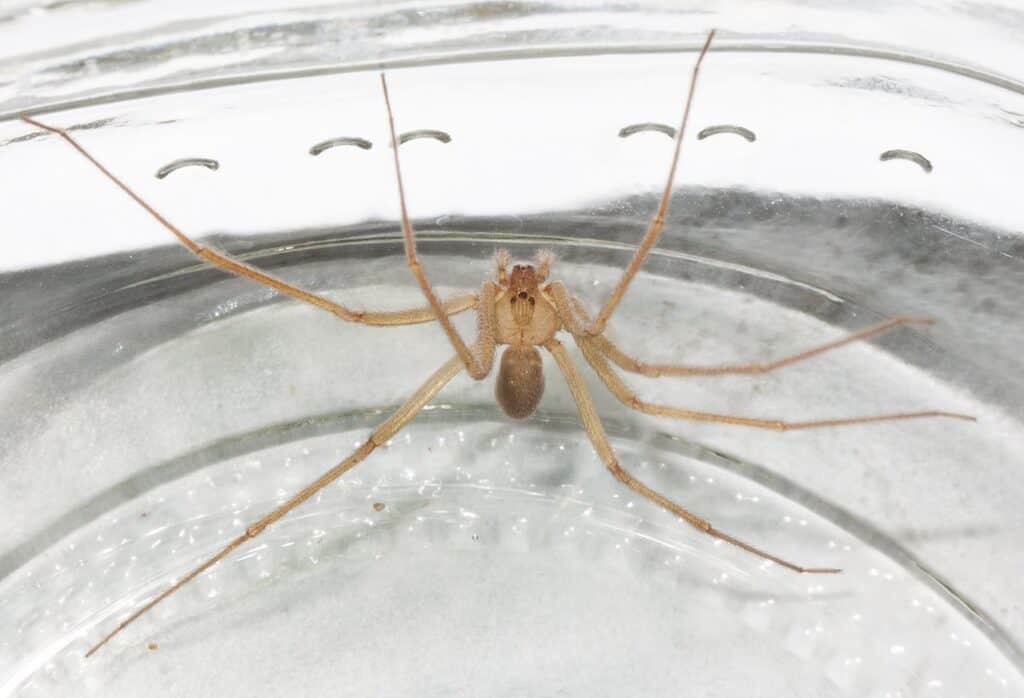
The desert recluse is found in Arizona.
©DesertTrip / CC BY-SA 4.0, via Wikimedia Commons – Original / License
Arkansas: Four
- Brown Recluse – Loxosceles reclusa
- Brown Widow – Latrodectus geometricus
- Northern Black Widow – Latrodectus variolus
- Southern Black Widow – Latrodectus mactans
California: Eight
- Arizona Recluse – Loxosceles arizonica
- Baja Recluse – Loxosceles palma
- Chilean Recluse – Loxosceles laeta
- Desert Recluse – Loxosceles deserta
- Martha’s Recluse – Loxosceles martha
- Russell’s Recluse – Loxosceles russelli
- Brown Widow – Latrodectus geometricus
- Western Black Widow – Latrodectus hesperus
Colorado: One
- Western Black Widow – Latrodectus hesperus
Connecticut: One
- Northern Black Widow – Latrodectus variolus
Delaware: One
- Northern Black Widow – Latrodectus variolus
Florida: Four
- Brown Widow – Latrodectus geometricus
- Northern Black Widow – Latrodectus variolus
- Red Widow – Latrodectus bishopi
- Southern Black Widow – Latrodectus mactans

The red widow spider is very uncommon and is a member of the black widow family, which is highly venomous.
©Florida Division of Plant Industry Archive / CC BY 3.0 US, via Wikimedia Commons – Original / License
Georgia: Four
- Brown Recluse – Loxosceles reclusa
- Brown Widow – Latrodectus geometricus
- Northern Black Widow – Latrodectus variolus
- Southern Black Widow – Latrodectus mactans
Hawaii: Four
- Brown Widow – Latrodectus geometricus
- Mediterranean Recluse – Loxosceles rufescens
- Southern Black Widow – Latrodectus mactans
- Western Black Widow – Latrodectus hesperus

The
Mediterranean Recluselives in Hawaii.
©Malpolon/Shutterstock.com
Idaho: Three
- Hobo Spider or Aggressive House Spider – Tegenaria agrestis
- Northern Black Widow – Latrodectus variolus
- Western Black Widow – Latrodectus hesperus
Illinois: Two
- Brown Recluse – Loxosceles reclusa
- Northern Black Widow – Latrodectus variolus
Indiana: Two
- Brown Recluse – Loxosceles reclusa
- Northern Black Widow – Latrodectus variolus
Iowa: Two
- Brown Recluse – Loxosceles reclusa
- Northern Black Widow – Latrodectus variolus
Kansas: Three
- Brown Recluse – Loxosceles reclusa
- Northern Black Widow – Latrodectus variolus
- Western Black Widow – Latrodectus hesperus
Kentucky: Three
- Brown Recluse – Loxosceles reclusa
- Northern Black Widow – Latrodectus variolus
- Southern Black Widow – Latrodectus mactans
Louisiana: Four
- Brown Recluse – Loxosceles reclusa
- Brown Widow – Latrodectus geometricus
- Northern Black Widow – Latrodectus variolus
- Southern Black Widow – Latrodectus mactans

Southern black widow spiders live in several U.S. states.
©Jeff W. Jarrett/Shutterstock.com
Maine: Zero
- No dangerously poisonous spiders occur in Maine.
Maryland: Two
- Northern Black Widow – Latrodectus variolus
- Southern Black Widow – Latrodectus mactans
Massachusetts: One
- Northern Black Widow – Latrodectus variolus
Michigan: One
- Northern Black Widow – Latrodectus variolus
Minnesota: One
- Northern Black Widow – Latrodectus variolus
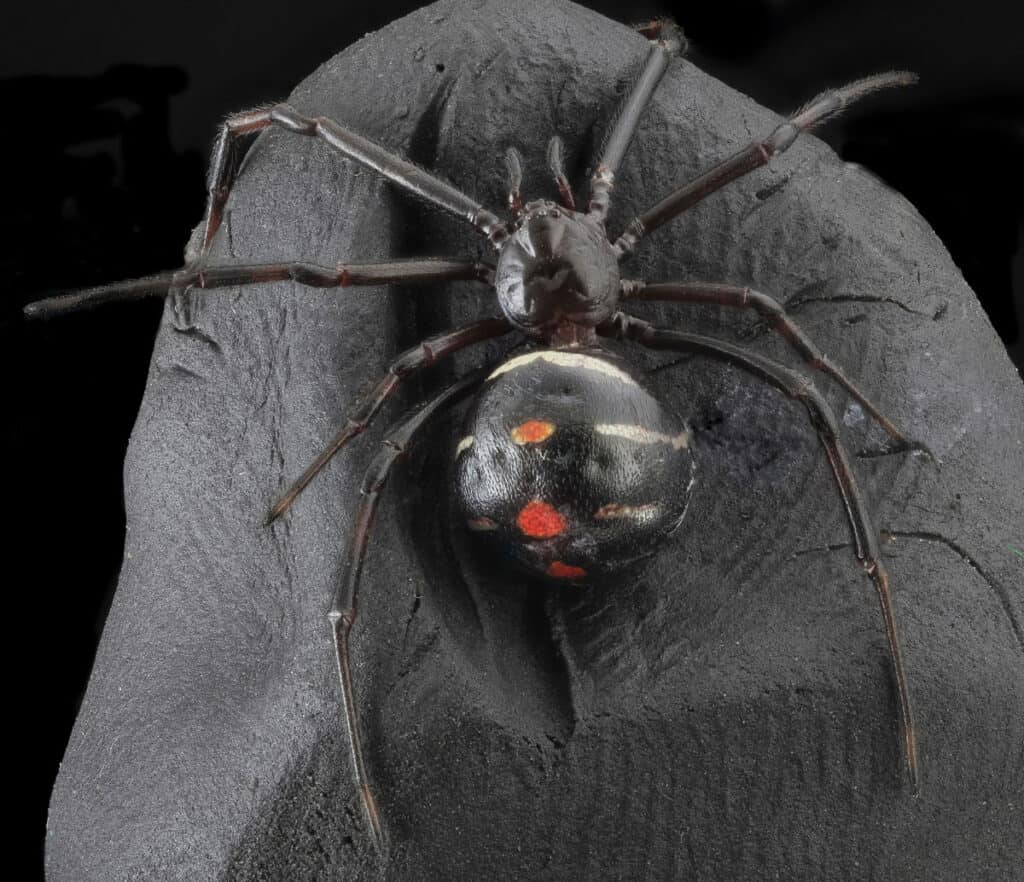
Several people are hospitalized each year due to bites from northern black widow spiders
©Porco_Rosso/Shutterstock.com
Mississippi: Four
- Brown Recluse – Loxosceles reclusa
- Brown Widow – Latrodectus geometricus
- Northern Black Widow – Latrodectus variolus
- Southern Black Widow – Latrodectus mactans
Missouri: Four
- Brown Recluse – Loxosceles reclusa
- Brown Widow – Latrodectus geometricus
- Northern Black Widow – Latrodectus variolus
- Southern Black Widow – Latrodectus mactans
Montana: Three
- Hobo Spider or Aggressive House Spider – Tegenaria agrestis
- Northern Black Widow – Latrodectus variolus
- Western Black Widow – Latrodectus hesperus
Nebraska: Two
- Brown Recluse – Loxosceles reclusa
- Western Black Widow – Latrodectus hesperus
Nevada: Three
- Desert Recluse – Loxosceles deserta
- Brown Widow – Latrodectus geometricus
- Western Black Widow – Latrodectus hesperus

On the abdomen of the Brown Widow spider there is an hourglass pattern.
©Decha Thapanya/Shutterstock.com
The State of New Hampshire: One
- Northern Black Widow – Latrodectus variolus
New Jersey: One
- Northern Black Widow – Latrodectus variolus
The State of New Mexico: Six
- Apache Recluse – Loxosceles apachea
- Arizona Recluse – Loxosceles arizonica
- Big Bend Recluse – Loxosceles blanda
- Desert Recluse – Loxosceles deserta
- Brown Widow – Latrodectus geometricus
- Western Black Widow – Latrodectus hesperus
New York: One
- Northern Black Widow – Latrodectus variolus
North Carolina: Three
- Brown Widow – Latrodectus geometricus
- Northern Black Widow – Latrodectus variolus
- Southern Black Widow – Latrodectus mactans
North Dakota: One
- Western Black Widow – Latrodectus hesperus
Ohio: Three
- Brown Recluse – Loxosceles reclusa
- Northern Black Widow – Latrodectus variolus
- Southern Black Widow – Latrodectus mactans
Oklahoma: Four
- Brown Widow – Latrodectus geometricus
- Brown Recluse – Loxosceles reclusa
- Western Black Widow – Latrodectus hesperus
- Southern Black Widow – Latrodectus mactans
Oregon: Two
- Hobo Spider or Aggressive House Spider – Tegenaria agrestis
- Western Black Widow – Latrodectus hesperus
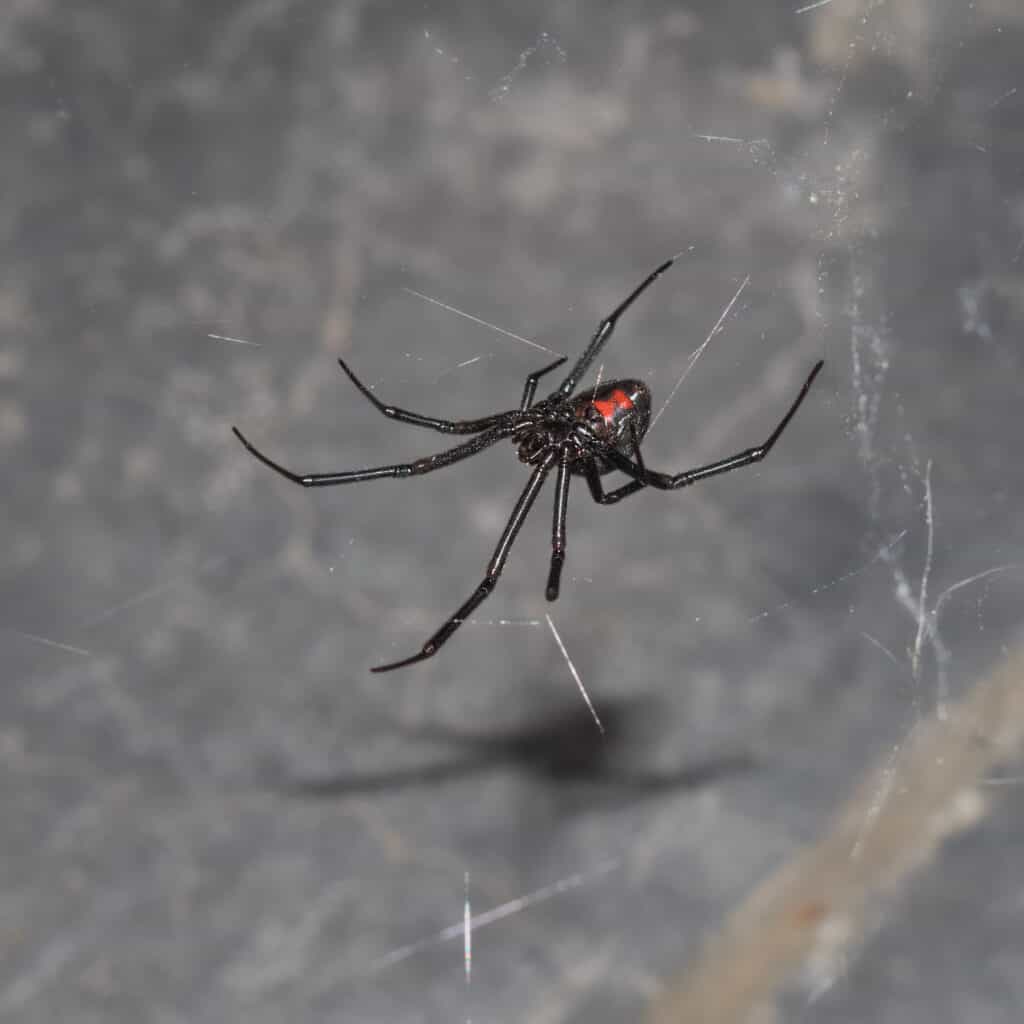
A female Western Black Widow waits in her web for potential prey. These remarkable spiders have a highly toxic venom but are very passive, shy creatures. Their silk is one of the strongest natural silks and they feed on cockroaches, earwigs, beetles, flies, and even other spiders.
©iStock.com/Shravan Sundaram Photography
Pennsylvania: Two
- Northern Black Widow – Latrodectus variolus
- Southern Black Widow – Latrodectus mactans
Rhode Island:One
- Northern Black Widow – Latrodectus variolus
South Carolina: Four
- Brown Recluse – Loxosceles reclusa
- Brown Widow – Latrodectus geometricus
- Northern Black Widow – Latrodectus variolus
- Southern Black Widow – Latrodectus mactans
South Dakota: One
- Western Black Widow – Latrodectus hesperus
Tennessee: Three
- Brown Recluse – Loxosceles reclusa
- Northern Black Widow – Latrodectus variolus
- Southern Black Widow – Latrodectus mactans
Texas: Ten
- Apache Recluse – Loxosceles apachea
- Arizona Recluse – Loxosceles arizonica
- Big Bend Recluse – Loxosceles blanda
- Brown Recluse – Loxosceles reclusa
- Brown Widow – Latrodectus geometricus
- Mediterranean Recluse – Loxosceles rufescens
- Brown Widow – Latrodectus geometricus
- Northern Black Widow – Latrodectus variolus
- Southern Black Widow – Latrodectus mactans
- Texas Recluse – Loxosceles devia
- Western Black Widow – Latrodectus hesperus
Utah: Three
- Hobo Spider or Aggressive House Spider – Tegenaria agrestis
- Desert Recluse – Loxosceles deserta
- Western Black Widow – Latrodectus hesperus
Vermont: One
- Northern Black Widow – Latrodectus variolus
Virginia: Two
- Northern Black Widow – Latrodectus variolus
- Southern Black Widow – Latrodectus mactans
Washington: Two
- Hobo Spider or Aggressive House Spider – Tegenaria agrestis
- Western Black Widow – Latrodectus hesperus
West Virginia: Two
- Northern Black Widow – Latrodectus variolus
- Southern Black Widow – Latrodectus mactans
Wisconsin: One
- Northern Black Widow – Latrodectus variolus
Wyoming: Two
- Hobo Spider or Aggressive House Spider – Tegenaria agrestis
- Western Black Widow – Latrodectus hesperus
Thank you for reading! Have some feedback for us? Contact the AZ Animals editorial team.

